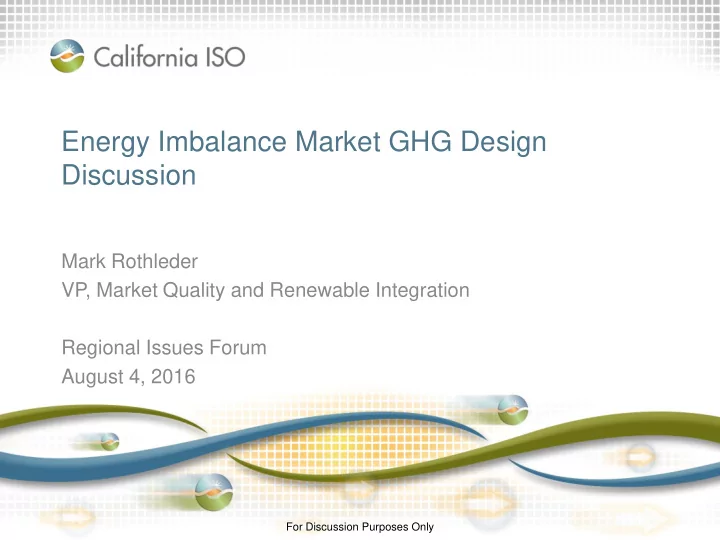

Energy Imbalance Market GHG Design Discussion Mark Rothleder VP, Market Quality and Renewable Integration Regional Issues Forum August 4, 2016 ISO Confidential For Discussion Purposes Only
Topic – Accounting for atmospheric effects of least cost dispatch • Least cost dispatch can have effect of sending low emitting resources to CAISO, while not accounting for secondary dispatch of other resource to serve external demand. • Least cost dispatch across CAISO and EIM allow CAISO renewables to displace external emitting resources. For Discussion Purposes Only Slide 2 ISO Confidential
All EIM balancing authority areas are balanced prior to the start of the EIM operating hour L = 2000 L = 4400 PACW G = 1800 G = 4400 PACE G1 = 200 G3 = 0 L = 3300 L = 21500 CISO G = 3300 NEVP G = 21500 G2 = 0 EIM Transfer Limits For Discussion Purposes Only Slide 3 ISO Confidential
Least cost dispatch to serve load across EIM area. Primary dispatch and GHG awards are aligned L = 2000 L = 4400 PACW G = 1800 G = 4400 PACE G1 = 200 G3 = 0 L = 3300 200 L = 21500 CISO G = 3300 NEVP G = 21300 G2 = 200 G2 receives 200 MW incremental primary dispatch G2 receives 200 MW GHG obligation 200 MW transfer from NEVP to CISO For Discussion Purposes Only Slide 4 ISO Confidential
Least cost dispatch to serve load across EIM area. Primary dispatch with “secondary” dispatch because G1 (Hydro) bids lower GHG adder than G3 (Gas) in PACE L = 2000 L = 4400 200 G = 1800 PACW G = 4400 PACE G1=200 to G3 = 0 to 200 200 200 L = 3300 L = 21500 CISO G = 3300 NEVP G = 21300 G2 = 0 G1 receives 200 MW primary dispatch & GHG obligation at resource’s emission rate G3 receives 200 MW incremental secondary dispatch 200 MW transfer from PACW to CISO For Discussion Purposes Only Slide 5 ISO Confidential
Least cost dispatch to serve load across EIM area. Primary dispatch with “secondary” dispatch because G1 (Hydro) bids lower GHG adder than G2 (Gas) in NEVP L = 2000 L = 4400 PACW G = 1800 G = 4400 PACE G1=200to200 G3 = 0 200 200 L = 3300 200 L = 21500 CISO G = 3300 NEVP G = 21300 G2 = 0 to 200 G1 receives 200 MW primary dispatch & GHG obligation at resource’s emission rate G2 receives 200 MW incremental secondary dispatch 200 MW transfer from NEVP to CISO For Discussion Purposes Only Slide 6 ISO Confidential
Least cost dispatch to serve load across EIM area. Primary dispatch with “secondary” dispatch for GHG because G2 did not submit a GHG bid L = 2000 L = 4400 G = 1800 PACW G = 4400 PACE G1=200 to G3 = 0 200 200 200 L = 3300 200 L = 21500 CISO G = 3300 NEVP G = 21300 G2 = 0 to 200 G1 receives 200 MW primary dispatch & GHG obligation at resource’s emission rate G2 receives 200 MW incremental secondary dispatch 200 MW transfer from NEVP to CISO For Discussion Purposes Only Slide 7 ISO Confidential
Several options have been considered to enable CARB to account for secondary dispatch (1 of 2) 1. Calculate emissions of secondary dispatch and assign GHG obligation to CAISO load imbalances 2. Require a minimum GHG bid for low emitting resources using the system emission rate 3. Create a hurdle rate using system emission rate for EIM transfers into ISO Legal/regulatory and market inefficiency impacts of options need evaluation For Discussion Purposes Only Slide 8 ISO Confidential
Several options have been considered to enable CARB to account for secondary dispatch (2 of 2) 4. Adjust the caps down or retire GHG allowances by the amount of estimated secondary dispatch effects 5. Ensure dispatch and accounting considers other costs such that lower cost but higher emitting resource gets allocated to support transfer to CA 6. Have CAISO become a regulated party and any obligations based on system or asset controlling supplier rate Legal/regulatory and market inefficiency impacts of options need evaluation For Discussion Purposes Only Slide 9 ISO Confidential
CARB is proposing regulatory amendments to account for GHG atmospheric impacts under EIM • CARB held a workshop on June 24 regarding potential changes to its regulations affecting the electricity sector. • CARB has issued proposed amendments to its cap and trade and mandatory GHG reporting regulations to take compliance period beginning January 1, 2018 http://www.arb.ca.gov/cc/capandtrade/capandtrade.htm • Comment period closes September 19, 2016. • CAISO will continue to work with CARB and stakeholders to examine alternatives. For Discussion Purposes Only Slide 10 ISO Confidential
Recommend
More recommend